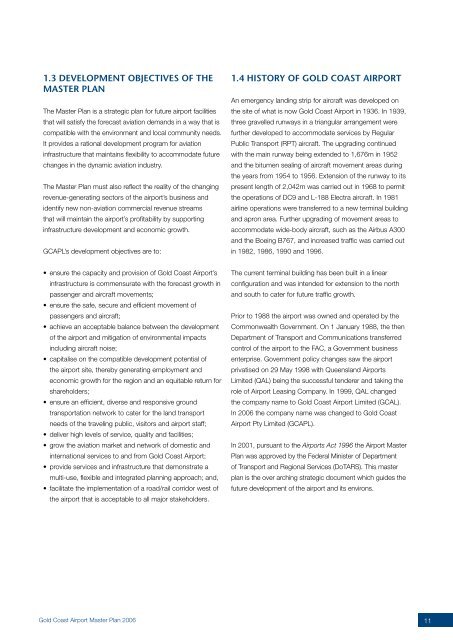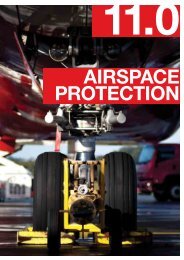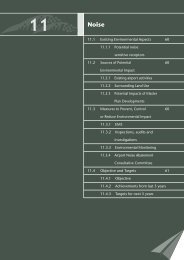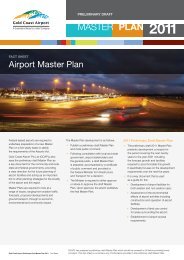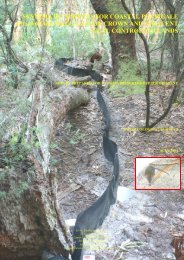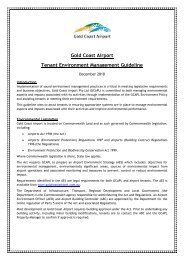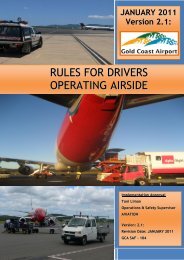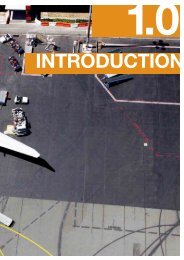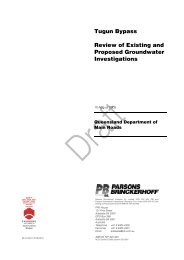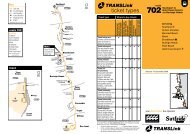Master Plan 2006 - Gold Coast Airport
Master Plan 2006 - Gold Coast Airport
Master Plan 2006 - Gold Coast Airport
You also want an ePaper? Increase the reach of your titles
YUMPU automatically turns print PDFs into web optimized ePapers that Google loves.
1.3 DEVELOPMENT OBJECTIVES OF THE<br />
MASTER PLAN<br />
The <strong>Master</strong> <strong>Plan</strong> is a strategic plan for future airport facilities<br />
that will satisfy the forecast aviation demands in a way that is<br />
compatible with the environment and local community needs.<br />
It provides a rational development program for aviation<br />
infrastructure that maintains flexibility to accommodate future<br />
changes in the dynamic aviation industry.<br />
The <strong>Master</strong> <strong>Plan</strong> must also reflect the reality of the changing<br />
revenue-generating sectors of the airport’s business and<br />
identify new non-aviation commercial revenue streams<br />
that will maintain the airport’s profitability by supporting<br />
infrastructure development and economic growth.<br />
GCAPL’s development objectives are to:<br />
1.4 HISTORY OF GOLD COAST AIRPORT<br />
An emergency landing strip for aircraft was developed on<br />
the site of what is now <strong>Gold</strong> <strong>Coast</strong> <strong>Airport</strong> in 1936. In 1939,<br />
three gravelled runways in a triangular arrangement were<br />
further developed to accommodate services by Regular<br />
Public Transport (RPT) aircraft. The upgrading continued<br />
with the main runway being extended to 1,676m in 1952<br />
and the bitumen sealing of aircraft movement areas during<br />
the years from 1954 to 1956. Extension of the runway to its<br />
present length of 2,042m was carried out in 1968 to permit<br />
the operations of DC9 and L-188 Electra aircraft. In 1981<br />
airline operations were transferred to a new terminal building<br />
and apron area. Further upgrading of movement areas to<br />
accommodate wide-body aircraft, such as the Airbus A300<br />
and the Boeing B767, and increased traffic was carried out<br />
in 1982, 1986, 1990 and 1996.<br />
• ensure the capacity and provision of <strong>Gold</strong> <strong>Coast</strong> <strong>Airport</strong>’s<br />
infrastructure is commensurate with the forecast growth in<br />
passenger and aircraft movements;<br />
• ensure the safe, secure and efficient movement of<br />
passengers and aircraft;<br />
• achieve an acceptable balance between the development<br />
of the airport and mitigation of environmental impacts<br />
including aircraft noise;<br />
• capitalise on the compatible development potential of<br />
the airport site, thereby generating employment and<br />
economic growth for the region and an equitable return for<br />
shareholders;<br />
• ensure an efficient, diverse and responsive ground<br />
transportation network to cater for the land transport<br />
needs of the traveling public, visitors and airport staff;<br />
• deliver high levels of service, quality and facilities;<br />
• grow the aviation market and network of domestic and<br />
international services to and from <strong>Gold</strong> <strong>Coast</strong> <strong>Airport</strong>;<br />
• provide services and infrastructure that demonstrate a<br />
multi-use, flexible and integrated planning approach; and,<br />
• facilitate the implementation of a road/rail corridor west of<br />
the airport that is acceptable to all major stakeholders.<br />
The current terminal building has been built in a linear<br />
configuration and was intended for extension to the north<br />
and south to cater for future traffic growth.<br />
Prior to 1988 the airport was owned and operated by the<br />
Commonwealth Government. On 1 January 1988, the then<br />
Department of Transport and Communications transferred<br />
control of the airport to the FAC, a Government business<br />
enterprise. Government policy changes saw the airport<br />
privatised on 29 May 1998 with Queensland <strong>Airport</strong>s<br />
Limited (QAL) being the successful tenderer and taking the<br />
role of <strong>Airport</strong> Leasing Company. In 1999, QAL changed<br />
the company name to <strong>Gold</strong> <strong>Coast</strong> <strong>Airport</strong> Limited (GCAL).<br />
In <strong>2006</strong> the company name was changed to <strong>Gold</strong> <strong>Coast</strong><br />
<strong>Airport</strong> Pty Limited (GCAPL).<br />
In 2001, pursuant to the <strong>Airport</strong>s Act 1996 the <strong>Airport</strong> <strong>Master</strong><br />
<strong>Plan</strong> was approved by the Federal Minister of Department<br />
of Transport and Regional Services (DoTARS). This master<br />
plan is the over arching strategic document which guides the<br />
future development of the airport and its environs.<br />
<strong>Gold</strong> <strong>Coast</strong> <strong>Airport</strong> <strong>Master</strong> <strong>Plan</strong> <strong>2006</strong><br />
11


